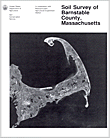The following is a map unit description from the "Soil Survey of Barnstable County, Massachusetts (Fletcher, 1993)"

CoC-Carver-Hinesburg loamy coarse sands, rolling.
These rolling, very deep, excessively drained and well drained soils are on side slopes and hills in areas of glacial lake deposits and ice-contact deposits. Slopes range from 8 to 15 percent. The soils make up about 0.3 percent (673 acres) of the survey area. They are mapped mainly in the Carver-Hinesburg-Nantucket general soil map unit. Areas are irregular in shape and generally range from 5 to 100 acres in size. They are about 45 percent Carver soil, 25 percent Hinesburg soil, and 30 percent other soils. The soils occur as areas so intricately mixed or so small that separating them in mapping is not practical.
Typically, the surface of the Carver soil is covered with an organic layer. This layer is about 2 inches of loose, undecomposed pine needles, leaves, and twigs and 1 inch of matted, partly decomposed and well decomposed organic material. The surface layer is light brownish gray, very friable loamy coarse sand about 3 inches thick. The subsoil is coarse sand about 33 inches thick. The upper 10 inches is strong brown and very friable, the next 9 inches is yellowish brown and very friable, and the lower 14 inches is brownish yellow and loose. The substratum to a depth of 65 inches or more is light yellowish brown, loose coarse sand.
Typically, the surface layer of the Hinesburg soil is dark brown, very friable sandy loam about 1 0 inches thick. The subsoil is about 22 inches thick. It is yellowish brown, very friable loamy coarse sand in the upper 12 inches and light olive brown, very friable loamy sand in the lower 10 inches. The substratum extends to a depth of 65 inches or more. It may be mottled. It is light brownish gray, friable fine sandy loam in the upper 6 inches and light olive brown, firm sandy clay loam in the lower part.
Included with these soils in mapping are small areas of Hinckley, Nantucket, and Plymouth soils. Also included are small areas where slopes are less than 8 percent or more than 15 percent, a few areas where stones are on the surface, and many areas where the Hinesburg soil is underlain by sandy and gravelly material below a depth of 60 inches. Included soils make up about 30 percent of this unit.
Permeability is very rapid in the subsoil and substratum of the Carver soil. Available water capacity is very low. The soil is droughty in late summer. Depth to the seasonal high water table is more than 6 feet.
Permeability is rapid in the subsoil of the Hinesburg soil and moderately slow in the substratum. Available water capacity is moderate. Depth to the seasonal high water table is generally more than 6 feet. In some areas, however, a perched water table is above the loamy and silty substratum in late fall, in winter and spring, and after periods of heavy precipitation.
Most areas are used as woodland. Many areas have been developed for homesites, and a few areas are farmed.
These soils are very poorly suited to cultivated crops. The low available water capacity of the Carver soil and the susceptibility to erosion are management concerns. Irrigation is needed for most cultivated crops. Mixing plant residue and manure into the surface layer increases the available water capacity. Farming on the contour or across the slope, terracing, stripcropping, including grasses and legumes in the crop rotation, growing cover crops, and applying a system of conservation tillage help to control runoff and erosion.
These soils are poorly suited to hay and pasture. The main management objective is the prevention of overgrazing, which reduces the hardiness and density of desirable plants. Proper stocking rates, timely grazing, and restricted use during wet periods help to maintain plant density and minimize surface compaction.
Because of the droughtiness of the Carver soil, this map unit is poorly suited to woodland. Thinning dense stands to standard stocking levels results in more vigorous tree growth. Diseased, deformed, and otherwise undesirable trees should be removed when the stands are thinned. The most common trees are pitch pine, white oak, scarlet oak, and white oak.
The slope is a limitation if these soils are used as sites for buildings. Land shaping is generally needed. Buildings and lots should be designed so that they conform to the natural slope of the land. Erosion is a hazard during and after construction. Planting well suited grasses as soon as possible after the surface is disturbed minimizes the erosion hazard. The droughtiness of the Carver soil is a limitation affecting lawns and shallow-rooted trees and shrubs. Adding a layer of topsoil and frequently watering during dry periods help to overcome this limitation.
These soils are limited as sites for septic tank absorption fields because the Carver soil may not adequately filter the effluent and the Hinesburg soil does not readily absorb the effluent. Because of the poor filtering capacity, the pollution of ground water is a hazard. In areas where the Hinesburg soil is underlain by sandy and gravelly material, excavations that extend to this material generally can overcome the restricted permeability. The slope is an additional limitation. It can be overcome by installing the distribution lines on the contour. Onsite investigation is needed to determine the suitability of a given area and the measures needed to overcome the limitations.